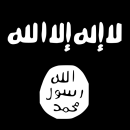After writing my post on Libya, AQIM, and the spotting of a flag that appeared to be al-Qa’ida in Iraq’s (AQI) hanging over a court building in Benghazi there has been much written over the past few days regarding this flag as well as one waved at a rally also held in Libya that showed the Islamic State of Iraq’s (AQI’s successor group) flag.[1] Earlier this morning, it sparked an interesting debate between Ed Husain and Will McCants on Twitter. The flags in question were the following two:
 al-Qa’ida in Iraq’s flag. This was the one that appeared on top of the court house in Benghazi.
al-Qa’ida in Iraq’s flag. This was the one that appeared on top of the court house in Benghazi.
 Islamic State of Iraq’s flag.
Islamic State of Iraq’s flag.
–
Husain contended that one should not describe this flag as an “al-Qa’ida flag,” stating: “By calling it AQ flag we give them what is not theirs. The Prophet used those colours in his raids against pagans.” On the other hand, McCantsargued that Muhammad may have used similar colors (i.e. black and white), but no other Islamic movement uses the exact same styled flag as the Islamic State of Iraq. Husain mentioned Hizb ut-Tahrir (HuT) as a counter example, yet that does not hold up to scrutiny, see:
 Hizb ut-Tahrir’s flag
Hizb ut-Tahrir’s flag
–
Indeed, in the case of the AQI and HuT flags they both use black as the background and contain theshahada (Islamic testament of faith: ‘There is no God, but God; and Muhammad is the Messenger of God’). While the Islamic State of Iraq’s only has the first half of the shahada at the top while on the bottom is the seal that Muhammad used in official documents. They all differ a bit though since they have different styled typeface. Further, if one were to contend as Husain did that “we” are giving al-Qa’ida something that is not theirs then we should look back and see what flags the Muslim prophet Muhammad actually used as well as the Rashidun Caliphate, Ummayad Caliphate, and the Abbasid Caliphate.
Click here to read the rest.
